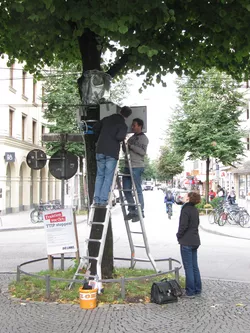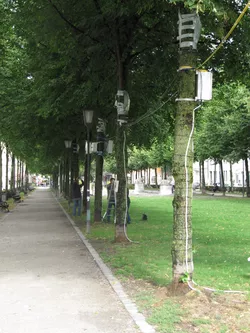SP7: Microclimate


Head: Prof. Dr. Stephan Pauleit
Affiliated Post-Doc: Dr. Mohammad Rahman.
Affiliated PhD Student: Eleonora Franceschi.
Background
There is strong evidence on urban cooling and run-off reduction via different types of UGI, with trees being mostly emphasized. Interestingly, these ESS are directly linked to the tree–water relationships, since the soil–plant–atmosphere continuum is the most critical determinant of gas exchange rates. However, understanding the dynamic relationships between ecological structure, function and ESS generated by urbangreenspaces in highly heterogeneous urban environments is yet a big challenge. The contributions of different types of vegetation and interaction between green and grey infrastructure in terms of ESS using a holistic approach is limited. The project aims towards two major impacts: improved human well-being and climate resilience, in particular, increase the quality and quantity of urban greenspaces, improvement of cooling effect, and decrease of heat stress. These impacts would be assessed using the ratio of open spaces to built-form, temperature reduction, and increased evapotranspiration through a measuring and modeling approach.
Objectives
The underlying objective is to understand the interaction of different types of surface coverage with or without vegetation, their spatial heterogeneity, as well as their vegetation dynamics such as annual cycles of water use, plant growth, and phenology.
Specifically, we want to understand the effect of:
(O1) Surface coverage types on spatio-temporal variation in energy and water flux;
(O2) Plant traits determining the intensity and extension of various ESS provision;
(O3) Interaction between microclimate and surface coverage characteristics.
We postulate:
(H1) Increasing UGI will improve the thermal comfort at all spatial and temporal scales;
(H2) Trees provide higher cooling and water retention benefits compared to grass or shrubs;
(H3) The built environment with less open space has an extended effect on heat trapping.
PhD: Nayanesh Pattnaik
Dissertation: Interaction of urban greenspaces and surface cover in terms of urban heat and run-off reduction.
Methods:
The subproject will result in new knowledge on the functioning of multilayered urban greenspaces and outdoor climate modification intensity for current and future climate conditions. Within stage 1, sampling sites will be selected in coordination with other subprojects (SP8 - Urban Trees, SP13 - Plant Systems, SP10 - Urban Drainage Systems) to represent important open space types such as streets and squares in densely built versus low density built. Attempts will be made to include four types of coverage namely impervious surface, shrub-grass, tree-grass and tree-shrub-grass to collect both continuous and sampled field data on meteorological and edaphic variables. Mobile and permanent weather stations will be used to measure bio-meteorological variables such as radiation, wind, temperature, humidity, black globe temperature, and edaphic variables such as soil temperature and moisture. Moreover, physical properties of each surface cover type along with the structural data such as leaf area index, diameter, and height of trees shrubs, and grasses will be collected. Data will be used to estimate shading depth and area, and sensible heat fluxes. Simultaneously, transpiration of trees using TDP sap flow sensors, shrubs (porometer) and grass (lysimeter) will be measured to calculate latent heat fluxes and crop coefficients. During stage 2, functional relationships between tree growth and water balances will be investigated using leaf water potential, chlorophyll content measurements, and soil hydraulic conductivity. Total transpiration, interception water loss and infiltration rate will be used to understand water balance and runoff coefficient. In stage 3, UGI parameters such as amount of vegetation, leaf area index, composition of the vegetation, and its connectivity will be systematically varied to develop and test prototypical UGI for cooling. Modeling is intended to be linked to the subproject on Indoor Comfort and Energy Consumptions of Buildings (SP6). Additionally, interactions are expected with the research on novel plant systems (SP13).
Outlook:
In Funding Period II, the findings on the functioning of multi-layered UGI and micro-climatic amelioration will be calibrated using thermal scanners and correlated with remotely sensed data. This will help development of models to assess ESS on a larger scale, not only in terms of intensity but also in terms of spatial extension.
Execution: Azharul Islam
The research aims to address the increasing urban heat island effect, which negatively affects human health and well-being, by studying how layered vegetation structures can enhance cooling efficiency and inform climate-resilient urban planning. Results from previous research in the RTG already showed the promise of a combination of tree, shrub and grass lawns, although trees were almost three times more effective in air cooling than shrubs, and shrubs were double as effective as grasses. However, relative effect sizes of the eco-physiological and morphological traits of different tree species at different growth conditions regarding planting and design strategies are yet to be explored. Therefore, it is important to have a 3D structural analysis of complex vegetation structures, followed by an assessment of microclimatic thermal regulations in contrasting scenarios and finally, to evaluate multidimensional canopy quality, facilitating the scaling from site to urban neighbourhoods. The main research questions are:
Does plant vertical diversity bring added benefit to thermal regulations?
Which plant functional traits have the largest influence on cooling benefits in relation to vertical heterogeneity?
How to optimize the vegetation vertical structure to enhance the thermal regulation in different urban settings/ or open spaces/ urban environments?
Intended methods:
Terrestrial (TLS) and aerial (ALS) laser scanning will be used to estimate tree and shrub crown volume, leaf area density, and canopy structure, while environmental data and ground based infrared thermal imaging will assess surface temperature. This data will overlay a LiDAR map to analyze how surfaces retain/release heat. To gain a better mechanistic understanding of the interactions between urban greens and the built environment in terms of thermal regulations, the three-dimensional computational fluid dynamic (CFD) model ENVI-met and scenario analysis across selected urban and suburban areas will be carried out. While the model can provide spatially and temporally highly resolved assessment of micrometeorological conditions, it does not yet incorporate the effect of tree dynamics (growth, evapotranspiration) in different urban environments. By incorporating field measurements on transpiration, heat flux, and tree growth dynamics, the project aims to optimize urban tree planting strategies for enhanced cooling, thermal comfort, and climate change mitigation. ENVI-met will simulate optimized thermal comfort using multi-layered tree and shrub structures, along with green coverage in urban areas, incorporating optimized air temperature predictions from the CityTree dynamic growth model. The links between microclimate and growth models will focus on the thermal impacts of urban trees, including their structure, shading, and cooling effects, to enhance thermal regulation.